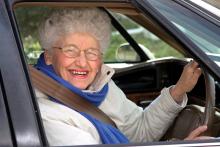Research by the RAC Foundation reveals the high risk posed by young drivers on the UK’s roads. Meanwhile the UK’s Institute of Advanced Motorists (IAM) is calling for stronger measures on drivers aged 70 or more.
Young drivers aged 17-19 only account for 1.5% of the UK’s driving population but feature in 12% of crashes involving serious injuries and fatalities. Around 20% of young drivers aged 17-19 will have a crash in the first six months after passing their test according to the study. The analysis carr
Research by the 5521 RAC Foundation reveals the high risk posed by young drivers on the UK’s roads. Meanwhile the UK’s 5125 Institute of Advanced Motorists (IAM) is calling for stronger measures on drivers aged 70 or more.
Young drivers aged 17-19 only account for 1.5% of the UK’s driving population but feature in 12% of crashes involving serious injuries and fatalities. Around 20% of young drivers aged 17-19 will have a crash in the first six months after passing their test according to the study. The analysis carried out for crashes during 2013, the most recent for which comprehensive data is available, shows that the safety risks also apply to passengers in cars driven by youngsters. The data shows that 234 passengers were killed or seriously injured in crashes involving a driver aged 17-19 at the wheel. Meanwhile some 2,144 teenagers suffered slight injuries in crashes involving drivers aged 17-19 during 2013.
Research carried out by the UK road safety charity3963 Brake has shown previously that young drivers are more likely to be under the influence of drugs while behind the wheel, as well as carrying out risky manoeuvres or avoiding wearing seatbelts.
The RAC Foundation has long campaigned for a graduated approach to driving licences, as is carried out in some countries. In addition those undertaking motorcycle training in the UK often have graduated licenses before being able to claim full entitlement. While the rate of crashes amongst young drivers has fallen in recent years, the RAC Foundation suggests that this is due in part alt least to the drop in the number of young people taking the driving test. High insurance costs have deterred many younger people from learning to drive. In addition, new cars benefit from better safety features and protection for occupants, lowering the risks.
The IAM points out that with age demographic changes, the number of drivers aged 70 or more is also increasing. The UK now has over 4.34 million drivers aged 70 or more, an increase of 11% from the 3.9 million in 2012. The number of drivers aged 80 or more topped 1 million in 2014 and has now risen to 1.17 million. There are 82,937 drivers aged 90 or more and 232 aged over 100, with Britain’s oldest driver now aged 107. Research shows that the numbers of older drivers will continue to increase as average lifetimes extend.
While older drivers typically have lower rates of crashes, IAM research shows that they can be involved in incidents all the same. The research reveals that the most common factors in a crash involving a person over 70 were: failing to judge another road user’s path or speed, poor turn-in or manoeuvre, losing control, illness or disability, dazzling sun; and nervousness, anxiety or panic.
At the same time, figures show that older drivers are proven to be the safest on the roads. Previous analysis by the IAM found that older drivers are involved in a smaller number of injury accidents than drivers under the age of 60. In 2011, people over 70 made up 9% of drivers but 6% of driver casualties, while drivers under 30 made up 20% of drivers but 35% of casualties.
In view of the changing age demographics, the IAM is calling for a government action plan for older drivers and that car manufacturers should consider older drivers in vehicle design. The IAM is also calling for better information for older drivers and their families, online self-assessment tools for older drivers and a wider availability of voluntary on-road driving assessments.
Young drivers aged 17-19 only account for 1.5% of the UK’s driving population but feature in 12% of crashes involving serious injuries and fatalities. Around 20% of young drivers aged 17-19 will have a crash in the first six months after passing their test according to the study. The analysis carried out for crashes during 2013, the most recent for which comprehensive data is available, shows that the safety risks also apply to passengers in cars driven by youngsters. The data shows that 234 passengers were killed or seriously injured in crashes involving a driver aged 17-19 at the wheel. Meanwhile some 2,144 teenagers suffered slight injuries in crashes involving drivers aged 17-19 during 2013.
Research carried out by the UK road safety charity
The RAC Foundation has long campaigned for a graduated approach to driving licences, as is carried out in some countries. In addition those undertaking motorcycle training in the UK often have graduated licenses before being able to claim full entitlement. While the rate of crashes amongst young drivers has fallen in recent years, the RAC Foundation suggests that this is due in part alt least to the drop in the number of young people taking the driving test. High insurance costs have deterred many younger people from learning to drive. In addition, new cars benefit from better safety features and protection for occupants, lowering the risks.
The IAM points out that with age demographic changes, the number of drivers aged 70 or more is also increasing. The UK now has over 4.34 million drivers aged 70 or more, an increase of 11% from the 3.9 million in 2012. The number of drivers aged 80 or more topped 1 million in 2014 and has now risen to 1.17 million. There are 82,937 drivers aged 90 or more and 232 aged over 100, with Britain’s oldest driver now aged 107. Research shows that the numbers of older drivers will continue to increase as average lifetimes extend.
While older drivers typically have lower rates of crashes, IAM research shows that they can be involved in incidents all the same. The research reveals that the most common factors in a crash involving a person over 70 were: failing to judge another road user’s path or speed, poor turn-in or manoeuvre, losing control, illness or disability, dazzling sun; and nervousness, anxiety or panic.
At the same time, figures show that older drivers are proven to be the safest on the roads. Previous analysis by the IAM found that older drivers are involved in a smaller number of injury accidents than drivers under the age of 60. In 2011, people over 70 made up 9% of drivers but 6% of driver casualties, while drivers under 30 made up 20% of drivers but 35% of casualties.
In view of the changing age demographics, the IAM is calling for a government action plan for older drivers and that car manufacturers should consider older drivers in vehicle design. The IAM is also calling for better information for older drivers and their families, online self-assessment tools for older drivers and a wider availability of voluntary on-road driving assessments.






